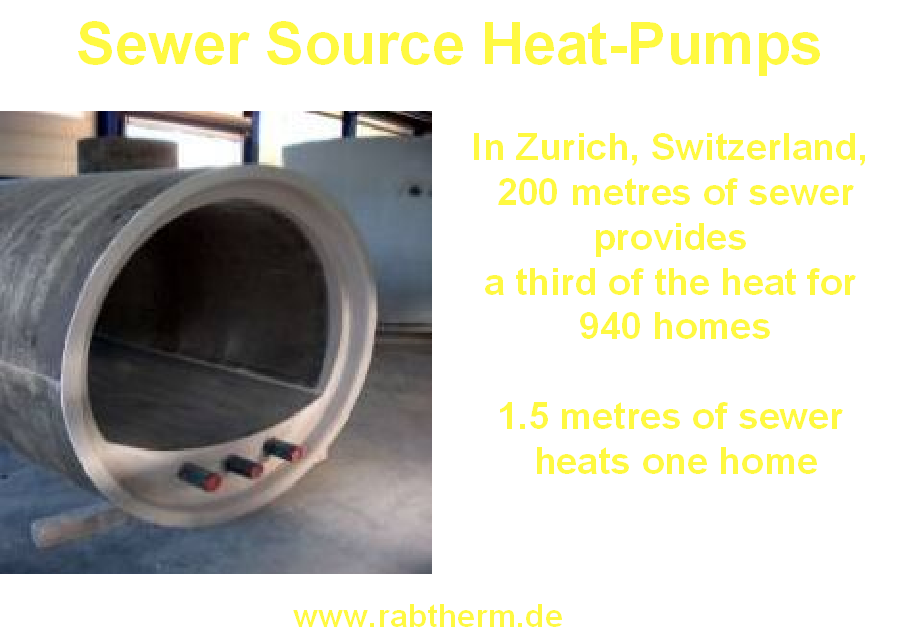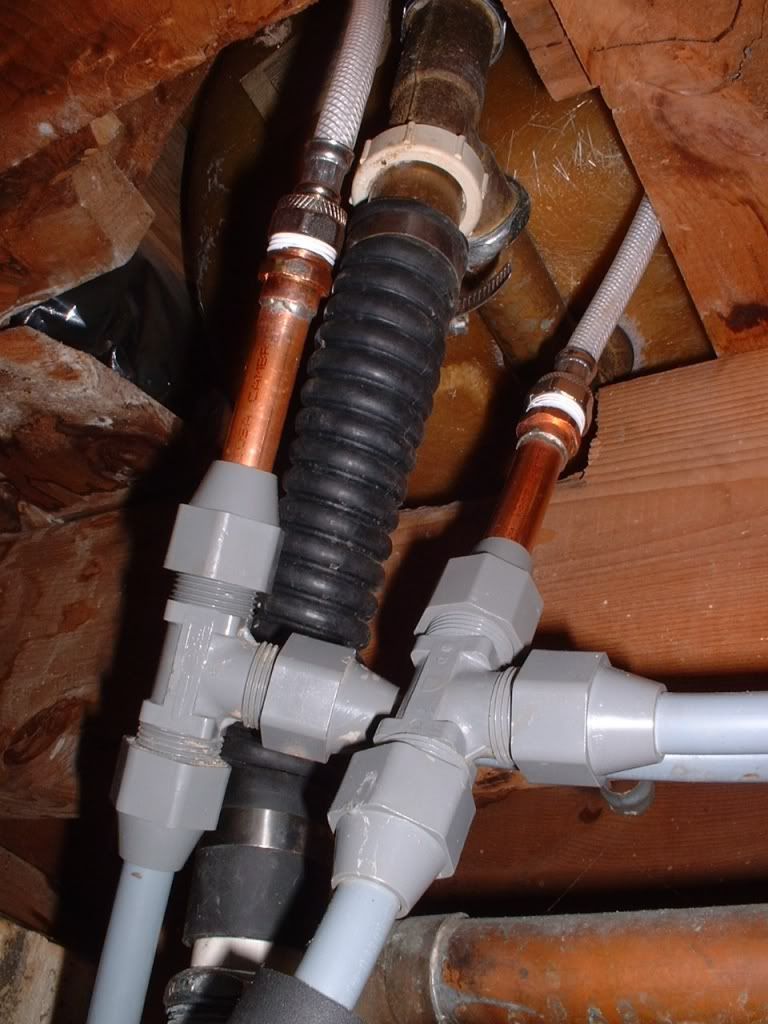
 |
|
|
#1 | |
|
Supreme EcoRenovator
Join Date: Mar 2009
Location: Portland, OR
Posts: 4,004
Thanks: 303
Thanked 724 Times in 534 Posts
|
There is an interesting entry in Wikipedia on Water Heat Recycling.
This photo is shown: The article states: Quote:
I also found that there is a company called GFX Technology that makes such a device. They have a PDF of performance curves located here. There's even a Bob Villa video . Here are other companies in the same business: http://www.renewability.com/powerpipe.htm http://www.retherm.com/ http://www.ecodrain.ca/ The important features I can see are: * counter-flow - drain water goes in one direction, incoming cold water goes in the opposite direction (larger 'delta-T', makes the efficiency higher.) * drain water flows in a thin film inside the heat exchanger - this assures maximum exposure of the hot drain water to the cold incoming water, making the efficiency higher. (question: is a special structure required for this to happen?) *copper construction assures good heat transfer. (question: is the coil soldered to the drain water pipe? * it also seems to me that encasing the whole assembly in insulating foam would improve the efficiency even more. I have seen projects where plastic 55 gallon barrels and long pieces of PEX are coiled inside to make such a system, but this compact copper unit seems to be elegant, compact efficient and highly buildable. Here are more photos of the GFX units: With domestic water heating being the second biggest energy use for homeowners, this seems to be a natural target for our efforts. Claims of efficiency seem to run as high as 50%, this would hold for fossil fuel use, and also for wood water heating, as well as for the size of a solar Domestic Hot Water (AKA: DHW) array required to supply DHW to a home or business. Best of all, no moving parts. Build It Solar has a relevant link here. Here is a link to a Grey Water Heat Recovery Calculator. Are the wheels turning? Regards, -AC_Hacker Last edited by AC_Hacker; 03-01-10 at 11:51 AM.. |
|
|
|

|
|
|
#2 |
|
Lex Parsimoniae
Join Date: Feb 2009
Location: Woburn, MA
Posts: 4,918
Thanks: 114
Thanked 250 Times in 230 Posts
|
One would think the coils should be insulated, if the basement air temp is low.
Today, the air temp in my basement isn't much warmer than the incoming city water. But, if your basement was heated, that coil is going to be warmed up to room temp after a while. So, insulation wouldn't be so good. |
|
|

|
|
|
#3 | |
|
Administrator
Join Date: Aug 2008
Location: Germantown, WI
Posts: 5,525
Thanks: 1,162
Thanked 374 Times in 305 Posts
|
Nope, this the natural way water flows through a vertical pipe.
Quote:
I'm a huge fan of these devices and think everyone should have one. The bad news for me is my sewer drain is over half way up my basement wall. So, I don't have much vertical drop to splice one in...
__________________
Current project - To view links or images in signatures your post count must be 0 or greater. You currently have 0 posts. To view links or images in signatures your post count must be 0 or greater. You currently have 0 posts. & To view links or images in signatures your post count must be 0 or greater. You currently have 0 posts. Last edited by Daox; 03-01-10 at 12:55 PM.. |
|
|
|

|
|
|
#4 |
|
Lex Parsimoniae
Join Date: Feb 2009
Location: Woburn, MA
Posts: 4,918
Thanks: 114
Thanked 250 Times in 230 Posts
|
The bad news for me is my sewer drain is over half way up my basement wall. So, I don't have much vertical drop to splice one in...
I have the same problem. Plus, the area where we make the hot water is half way across and on the other side of the basement. However, I think this idea might be workable by using a short unit fed from the tub drain which is about a yard above the lowest input to the sewer plumbing. My tub is Very close to being right on top of the main sewer exit pipe. If I could install a short (fat?) 24" unit in the shower drain line, and reroute the cold water going to the tub, I could take the chill out of the cold water, making it possible to use less hot water from the boiler..  I would insulate the exchanger, fer sure.. Edit: Saw this.. Trimline Design Centre: Watercycles HX-3030 That HX-3030 looks petty simple to make. According to what my old moonshiner Grandpa from NC told me, one could make a copper tube coil by filling the tubing with sand. Use wood plugs in each end and the hard-packed sand would allow the tube to bend without kinks.. So, maybe using a dowel that was a bit smaller than the large copper drain pipe, I could make a nice tight coil around it, then force the coil onto the drain pipe.?. Insulate the whole thing and plug-n-play! This is really starting to sound like a good DIY project!  Last edited by Xringer; 03-01-10 at 04:48 PM.. Reason: adding idea |
|
|

|
|
|
#5 |
|
Lex Parsimoniae
Join Date: Feb 2009
Location: Woburn, MA
Posts: 4,918
Thanks: 114
Thanked 250 Times in 230 Posts
|
Hello Ben, (If you are around)
I'm thinking of stealing your design and hacking it!  I'm daydreaming of a horizontally mounted Shower Waste Water Heat Recovery heat exchanger. (On the ceiling of the laundry room). Since the waste water is at near zero PSI, and I want keep the heat inside, and make it cheap.. How about using 2" or 3" PVC for the water-jacket? I would attach a 2" PVC flex hose to my tub drain, connect it to the SWWHR input and drop the waste output with another flex hose into the washing machine drain pipe. The trick would be sealing the 1/2 copper cold water pipe (L type) in the center of the end caps. Since the gray water has such low pressure, it might not be a big problem. Perhaps the copper supply pipe need not be in the center.?. Maybe it can be positioned near the bottom of the PVC, to insure it's completely covered by the flowing waste water.. The PVC tube would be about 4 or 5 feet long and not quite level, so it will fill up with gray water, before pouring out the higher end. Insulate it well and start using less oil to heat my shower water! Edit: Someone invented the PVC version. Saw it on Ebay. Waste water Heat exchanger Water Heater Green Energy - eBay (item 170390818624 end time Apr-02-10 19:06:03 PDT) Last edited by Xringer; 03-04-10 at 01:48 PM.. Reason: Found PVC product |
|
|

|
|
|
#6 | |
|
Supreme EcoRenovator
Join Date: Mar 2009
Location: Portland, OR
Posts: 4,004
Thanks: 303
Thanked 724 Times in 534 Posts
|
Quote:
Some possible problems I can think of... * Expansion differences between copper pipe & PVC could prove difficult to seal. Do you know what the thermal expansion index is of PVC & copper? * A very good feature of the GTX configuration is that the waste water falls straight down and 'scours' the surface of the exchanger pipe. So, on a more horizontal configuration, you may want to allow for clean-out ports as are built into many ABS elbows & sink traps. Overall, the PVC/copper combo could be a real cost-effective plan. Regards, -AC_Hacker |
|
|
|

|
|
|
#7 |
|
Journeyman EcoRenovator
Join Date: Dec 2009
Location: Maynard, MA Eaarth
Posts: 383
Thanks: 78
Thanked 39 Times in 32 Posts
|
You can do this set up right at the shower drain, or at the dishwasher drain, and get a little more heat than at the waste invert.
Also, you if can do a heat pump exchange in the sewerpipe:  then you can heat a home with as little as 5' of sewer pipe. |
|
|

|
|
|
#8 |
|
Lex Parsimoniae
Join Date: Feb 2009
Location: Woburn, MA
Posts: 4,918
Thanks: 114
Thanked 250 Times in 230 Posts
|
 DBHL No. HD7983c, 1-1/2 In. x 3/4 In. Flexible Rubber Coupling Model # HD7983C Store SKU # 316954 $3.39/EA-Each Maybe a couple of these boots on some PVC reduced down to a 1.5" OD, and use a 3/4" copper pipe down the center? (I have 3/4 'L' in stock). It's kinda funny looking up at the 'temporary' drain I installed on the bottom of our pretty new FG tub back in the late 70s.. My wife demanded we replace the old iron tub. It was the wrong color. Pink! The tiles around the tub had been leaking since,, maybe 1956? When the house was built. A blue three section FG wrap-around wall with matching tub was her choice. The new tub drain was in the wrong place and I needed an off-set drain connection.. I went down to the nearby auto-supply store and got some radiator hose and SS clamps. The hose and clamps still look dang good.   I'll bet you guys have never seen polybutylene pipes and fittings that lasted over 25 years!  The only one that dissolved was on the hot water side, where water leaked out of the tub faucet and ran down the outside of the screw-in fitting. It seems to be the mix of air and water on the outside that eats them. I just changed out the old tub faucets last week. The new ones look great. I had to get rid of the upper pipe to the shower head (all polybutylene), because I broke it while screwing in the new shower head! Replaced it with PEX and quick-PEX fittings. Not knowing they can't hack very high temperatures.. Read the specs after installation..  |
|
|

|
|
|
#9 |
|
Administrator
Join Date: Aug 2008
Location: Germantown, WI
Posts: 5,525
Thanks: 1,162
Thanked 374 Times in 305 Posts
|
You do want the tube to crush up against the main drainage line. This provides more contact surface area and thus better efficiency.
__________________
Current project - To view links or images in signatures your post count must be 0 or greater. You currently have 0 posts. To view links or images in signatures your post count must be 0 or greater. You currently have 0 posts. & To view links or images in signatures your post count must be 0 or greater. You currently have 0 posts. |
|
|

|
|
|
#10 |
|
Lurking Renovator
|
Been lurking for a bit, time to get in. You guys have some really good stuff here, especially for the "think outside the box" type of DIY.
These are 'thin film/falling film' exchangers, we use these types(plate/fin) in cryogenics, they are the most efficient design. Although to be such it needs to have 'intimate'(ha-ha)contact on the same wall. I want to do a modded version, cu drain thru the middle, supply thru next larger cu pipe outside, pressurized, providing 'intimate' contact for best transfer. This would also work pretty well horizontal, which I need 1 of. Just like Xringer/Ben's pic, only 2/3'' pipe. I just need to get it done, and have some faith in my sweat abilities. I shouldn't 'sweat' it, I plumbed my whole house with no leaks. Yet! Ya'll have a good day, I got to get to the grind. I'll check in time to time. Tim |
|
|

|
 |
|
|